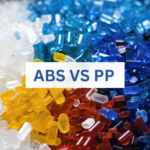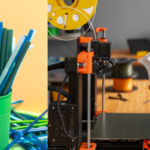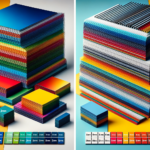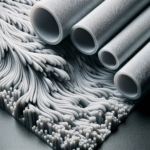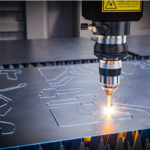Polyethylene Terephthalate Glycol, usually known as PETG is a thermoplastic polyester with good chemical resistance, durability and excellent formability for manufacturing. It can easily be vacuumed, and pressure formed or heat bent due to the low forming temperature. This makes it popular for printing projects (3D) and other heat-forming techniques that involve consumers and commercial applications. It is suitable for fabrication techniques such as routing, bending, die-cutting and many more.
Table of Contents
What is the composition of PETG?
Polyethylene Terephthalate Glycol is derived from the composition of polyethylene terephthalate (PET) which is a type of plastic used for packaging food and drinks. Since it has a similar composition as PET, where Ethylene glycol is replaced with another molecular group, i.e., cyclohexanedimethanol (CHDM). Glycol indicates the G in PETG which increases the strength and toughness of a compound as well as impact resistance and ability to withstand high temperatures. PETG is clearer, less brittle and easily printed as compared to PET.
How was PETG made?
In 1941, PET was invented by two British scientists, John Whinfield and James Dickson, when they combined phthalic acid and glycol to create a material that could be pulled out into long fibres. The material was in high demand as a food and beverage packaging product and in textile industries. But when PET gets hot, it tends to crystallise and turn opaque, which makes it weaker. PETG replaced the traditional glycol which was used in PET production for Cyclohexane Dimethanol. This makes the material stronger by preventing crystallisation at higher temperatures. The addition of Cyclohexane Dimethanol made the PETG suitable for use in 3D printing and other type of higher-temperature applications.
What is PETG used for?
Since it is resistant to heat, impacts and solvents, it is used in many different fields. The following are its uses in different industries:
1. Indoor and outdoor signage displays
PETG sheets are easy to screen-print, hence used in advertising and signage industries. Due to its versatility, durability, recyclability and impact-resistance nature, it is used for displays, sign-making, glazing and protective screens. Its UV-ray-resistant nature allows it to be used outdoors too, which requires protection from ageing due to sunlight. Since PETG can be coloured and create eye-catching storefront signage, therefore, it is mainly used to create display stands of various colours, shapes and sizes.
2. Pharmaceutical and medical applications
PETG has a rigid structure and can withstand the sterilisation process, so it is an ideal substance for medical implants as well as for packaging medical devices and pharmaceutical items.
3. Machine guards
Machinists and manufacturing engineers use PETG to create parts such as protective guards, testing components, manufacturing tools and aids. Since it has rough resistance to heat and chemical stressors, PETG machine guard products last for many years. Thus, it is considered to be a good option than polycarbonate.
4. Containers for food and beverages
PETG meets FDA regulations for food storage containers due to its good chemical resistance and ease of thermoforming. Therefore, it is used to make cooking oil containers, drinking bottles and packaging of cosmetics because it is also cheap, lightweight and strong.
5. 3D printing
It is an excellent material to use in 3D printers as it is strong, durable, chemical and thermal resistant as well as odourless while printing. Furthermore, PETG filament also prints easily and provides a good layer adhesion with the correct print settings.
Is polyethylene terephthalate glycol safe for the environment?
PETG is not fully biodegradable, and it may take decades to break down completely when sent to the landfill. However, it can be easily recycled using chemicals that break the polymer chains back down to their original components, which are used as raw materials to manufacture new polymers. Creating fresh plastics requires a large amount of water and energy. Therefore, recycling plastics back into production can reduce the consumption of natural resources. PETG products can be prevented by recycling from breaking down into microscopic fragments that pollute the oceans, which can threaten aquatic life as well as the water supply of the world.
Properties of PETG
- High thermal stability
- High chemical resistance
- Good clarity
- High impact resistance
- Durability
- Transparency
- Ductility
- Food-safe material
- Ease of Use
- Extrusion temperature must be between 230° C- 260° C
- The rate of print speed must be 40-60 mm/s.
- The heating tray should not exceed 80° C. If it exceeds more than 80° C, it can make it sticky while printing and make it difficult to remove.
- Quickly take moisture, therefore, better to keep it in a cool and dry place.
Print settings of PETG
| Printing Settings | Values |
| Recommended extrusion temperature | 230°C- 260°C |
| Bed temperature | 80°C-90°C |
| Speed of printing | 40-60 mm/s |
| Speed of retraction | 35-40mm/s |
| Distance of retraction (direct drive extruders) | 2-4mm |
| Distance of retraction (Bowden extruders) | 5-7mm |
| Height of layer | 0.28mm |
| Flow rate/ Flow of filament | 95-100% |
| Material of bed | PEI/ Polyetherimide surface |
Advantages of PETG
Polyethylene terephthalate glycol has many advantages, and they are as follows:
1. Strength and affordability
PETG’s strength and impact resistance make it ideal for glazing and high-strength display units, as well as ideal for packaging, displays and signage. Since it is one of the most affordable plastics in today’s market, it is a viable option for people who use 3D-printed products at home or offices.
2. Food safety and recyclable
PETG is an FDA-compliant plastic for food, beverage and medical packaging, which makes it legal to use for a huge variety of products, proving its safety around food products. PETG is also fully recyclable, it also reduces waste and the negative impacts on the environment.
3. Formability
Formable in both vacuum and thermo makes PETG heat-resistant but not unmeltable. It becomes very soft and pliable at the right temperature without losing its original strength. That’s how it can be formed into a variety of shapes or extruded into sheets through injection modules.
4. Easy to colour
The colourless and transparent feature of PETG allows for unique effects to create different appearances so that it can be coloured or blended easily, it attracts customers for display units.
5. Non-toxic and odourless emissions
During printing in 3D, PETG is non-toxic and odourless, which makes it perfect to use for a home as well as for an office.
Explore our range of PETG materials! Durable, versatile, and perfect for a variety of applications. Visit us now for top-quality PETG solutions
Disadvantages of PETG
Polyethylene Terephthalate Glycol has a few disadvantages and needs to be taken care of, particularly with temperature parameters. Other disadvantages are as follows:
1. More prone to oozing
PETG tends to ooze more than PLA or ABS during the printing process and to stabilise it; some different bridging and retraction techniques have to be used. As a result, to remove any blemishes, more post-processing will be required.
2. More brittle if not stored correctly
If not stored correctly, it will absorb water and become more brittle. Therefore, PETG has to be stored in a dry environment.
3. Environmental issues
Like any other plastic material, PETG harms the environment if not disposed it correctly. It takes decades to decompose and can lead to microplastics being fed into the world’s oceans. However, it is recyclable which can remove these environmental problems.
Conclusion
PETG is a versatile and adaptable plastic material used for 3D printing that has many uses and advantages for both professional and amateur users. You may produce high-quality, useful items that satisfy your particular demands and specifications by understanding their properties, benefits, advantages, disadvantages and applications as well as the best printing techniques. PETG filament can assist you in realising your ideas and pushing the limits of 3D printing innovation, regardless of your background—medical, design, engineering, or artistic.
